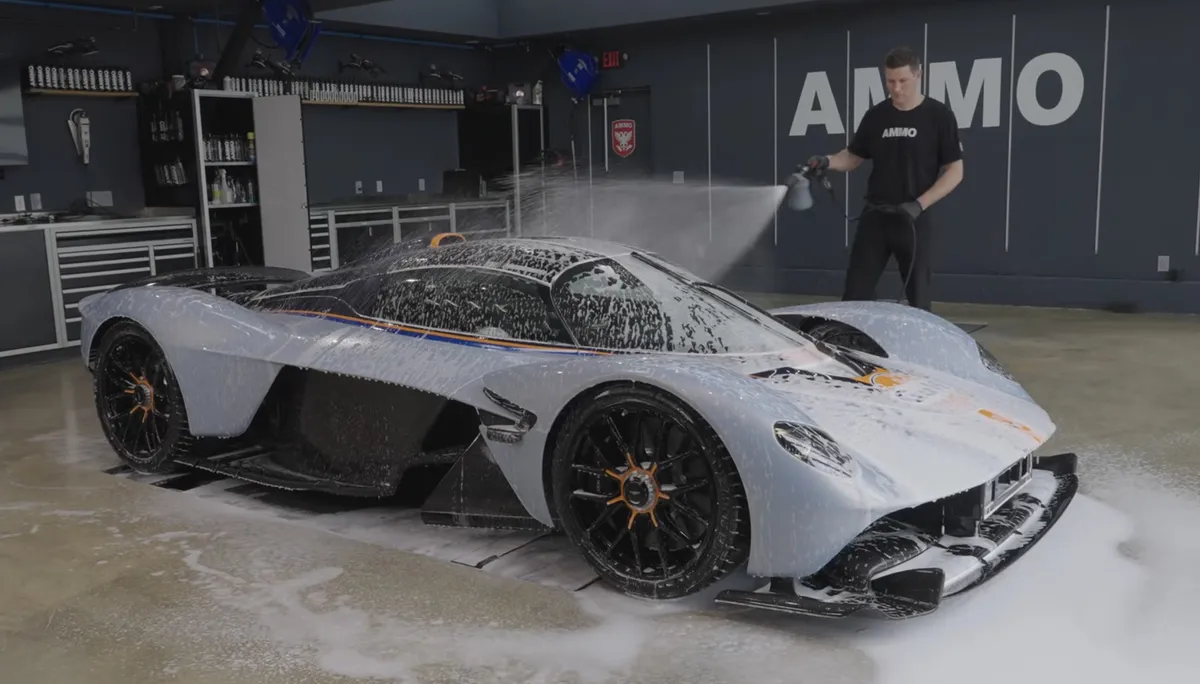
The Aston Martin Valkyrie, an ultra-rare supercar, recently arrived at a detailing studio delivered by a specialized team from Aston Martin. This high-performance vehicle required a comprehensive detailing service, including meticulous paint correction and the application of PPF (Paint Protection Film). The detailing expert faced an extraordinary challenge: navigating a cabin filled with complex buttons that could potentially lead to costly mistakes. For instance, pressing a certain button on the dashboard could result in an eye-watering $8,000 repair, while another button on the steering wheel could cost a staggering $220,000—almost the price of a luxury Mercedes-Maybach S-Class. Given the significant costs associated with these buttons, it’s advisable to avoid them entirely.
Driving the Valkyrie from the trailer into the detailing shop was no small feat. The expert was in command of a vehicle valued at $4 million, where a single wrong move could be financially devastating. With the car’s headroom tight, the detailer found himself squeezed inside, barely able to see outside, emphasizing the need for caution. The Valkyrie, designed by the renowned automotive engineer Adrian Newey, with contributions from Andy Palmer and Christian Horner of Red Bull Racing, is a masterpiece of engineering. Only 275 units of this supercar were produced, all of which were hand-built and sold out even before their official debut at the 2019 Geneva Motor Show.
Each Aston Martin Valkyrie is delivered to its owner with custom features, including helicopter-grade, noise-canceling headphones designed to protect the driver’s ears from the roar of its powerful V12 engine. This level of exclusivity means that only loyal customers were prioritized for ownership. The starting price for each unit was around $3.5 million, with many exceeding the $4 million mark depending on the owner's specific requirements. According to a recent Bloomberg report, the maintenance and service costs alone could soar to approximately $450,000 over three years, making ownership a significant financial commitment.
The Valkyrie is powered by a 6.5-liter naturally aspirated V12 engine developed in collaboration with Cosworth, making it the world's most powerful naturally aspirated series-production V12. When paired with an electric motor, it delivers a staggering 1,160 horsepower (1,176 metric horsepower). A seven-speed single-clutch automated manual transmission channels this power to the rear wheels, enabling the Valkyrie to accelerate from 0 to 60 mph (0 to 97 kph) in just 2.6 seconds, with a quarter-mile time of 7.7 seconds and a top speed of 220 mph. Each unit has a unique name, and the one featured in this detailing session is called "Gulf," inspired by aviation and adorned in the iconic Gulf livery.
The model that arrived at the detailing shop is the Valkyrie Spider, distinguished by its removable carbon fiber roof. Aston Martin produced only 85 of these Spiders, further enhancing their rarity. This British-made supercar boasts lightweight magnesium alloy wheels, measuring 20 inches in the front and 21 inches in the rear, fitted with Michelin Pilot Sport Cup 2 tires. Notably, there is not a single steel component in the Valkyrie; it features all-carbon fiber bodywork built around a carbon fiber Monocell manufactured by Multimac. Despite its impressive power, the car is known for its impracticality, including a minuscule frunk that is even smaller than one might estimate.
The Valkyrie also boasts what is potentially the most expensive windshield wiper in existence, designed entirely from carbon fiber and impressively large. Unlike the Tesla Cybertruck, which did not undergo extensive aerodynamic testing, the Valkyrie was validated in the world's fastest wind tunnel at Rail Tec Arsenal, ensuring its performance capabilities.
The detailing process begins with a thorough wash of the Aston Martin's exterior. The expert utilizes a brush to meticulously clean every crevice of the car. Due to its design, akin to a Formula 1 car, the Valkyrie can only be lifted for detailing like a race car during tire changes. This means the detailer must lay on the floor to reach underneath the vehicle, using specialized solutions to prevent any scratches to the fine paintwork.
The polishing procedure is an extensive process that takes several days to complete. Following polishing, the car undergoes another wash to remove any potential residue before the application of PPF. Covering the Valkyrie with PPF is a meticulous task that may take over a week to complete, particularly as the owner requested additional layers in hard-to-reach lower sections of the vehicle.
When it comes to the interior, the detailer must exercise utmost caution, as this is where the high-risk buttons reside. Fortunately, the Valkyrie is a brand-new car that has never been driven, making the cleaning process a bit easier. As the detailer prepares to work inside the vehicle, he removes his shoes, ensuring that the pristine condition of the interior is maintained.
In summary, detailing the Aston Martin Valkyrie is not just a job; it’s an intricate process that requires precision, care, and an understanding of the supercar's unique features. With its blend of performance, luxury, and rarity, the Valkyrie stands as a testament to automotive engineering at its finest.